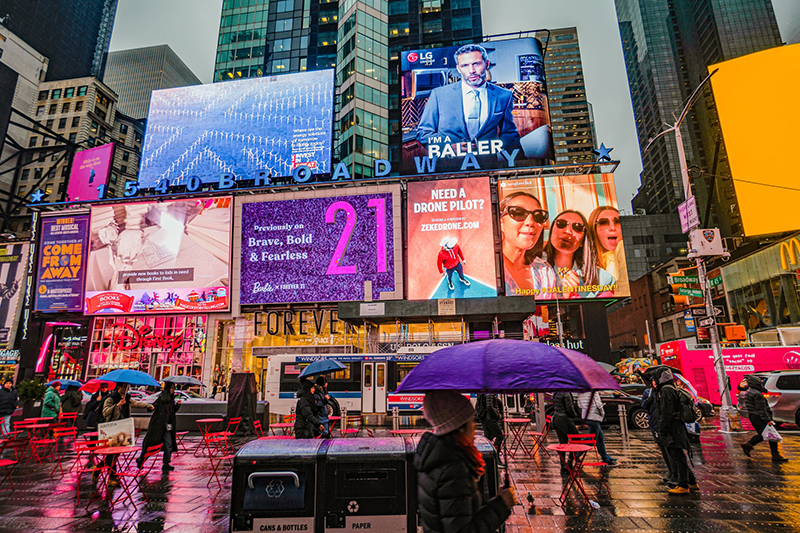What Are Digital Signages?

Digital signages are screens that are used to display dynamic content for the purpose of awareness, marketing, or internal communication. They can be in the form of projections, LCD monitors, walls, kiosks, and quick service restaurant menus.
Digital signage can be used to promote your digital content in public spaces in an attractive way. It can also be utilized to display multimedia content like welcome messages, corporate messages, moving images, live weather conditions, public information, and emergency messages.
But how does digital signage work? Continue reading to learn more about digital signage, its types, and how it can be beneficial for your business.
Why Is Digital Signage Important?

There are countless perks of implementing digital signage solution to deliver your marketing messages. These include:
- Reduced Perceived Wait Time. Digital signs are a great way for people to pass the time when waiting for their turn in different situations.
- Enhanced Communications. Digital signage networks allow businesses to communicate more effectively with their customers. They also enable employees in corporate offices to communicate easily, which can boost productivity and employee engagement. This is because people digest information more effectively with visual elements, which are at the core of any digital signage system.
- Maximized Profit. Digital displays are more likely to convert leads into customers with automated content, especially when there are discounts or special offers involved.
- Convieinet Content Management. Digital signage software solutions make it easier for business owners to regularly change their content in multiple locations without requiring much effort.
What Are the Types of Digital Signage?

There are various types of digital signage technologies, which include:
- DOOH Outdoor Advertising Displays. DOOH or Digital Out-of-Home electronic displays are intended for advertising. They’re usually installed outdoors, and they can be of any size.
- Digital Standees. These are LCD displays that are usually installed in receptions and hotel lobbies. They’re great for making announcements, dynamic wayfinding, promoting posters, and improving customer experience.
- Digital Menu Boards. These are used in restaurants to let customers browse the menu in an intuitive way while they wait in line for their turn. The best thing about these boards is that they’re dynamic. In other words, if a certain item is withdrawn, added, or out of stock, the boards can be updated in real-time.
- Video Walls. A video wall in Singapore comprises multiple screens grouped to make one big display. This is one of the best digital signage solutions for exhibitions and product launch events.
- Interactive Displays. As you might’ve guessed, interactive screens enable customers to interact with the content being displayed. Some examples of that include self-ordering kiosks, digital maps, and store directories in shopping malls.
- Electronic Shelf Labels. Electronic shelf labels enable mega store managers to update prices and other product information in real-time. They can also be used to display the expiration date and warranty information.
- Immersive Displays. These digital signage systems are often used for entertainment, like VR and 3D content.
Digital Signage Hardware
Traditionally, digital signage was all about using simple screens displaying images or videos, but technological advancements and business demands have paved the way for more creative applications of electronic signage.
There are multiple forms of digital signage hardware that you can choose from depending on what you intend to do, which include:
Multi-Touch screens
Multi-touch digital screens allow users to interact with the digital signage boards using more than one finger at the same time. This makes it easier for the user to use gestures and other forms of input to utilize interactive content. Not to mention, this interactive digital signage technology allows more than one person to use the digital sign at the same time.
There are two primary digital display types that accept multi-touch input: capacitive touch and infrared technology. Capacitive touch screens can detect any object made of conductive materials, while infrared LED displays can detect objects made of any materials.
Beacon Technology
Beacons are devices that utilize unique identifiers, where each object is assigned a beacon. This allows digital signage providers to bridge the product and the displays with content. This technology is quite popular in automated tours and proximity marketing.
Some types of beacons used in the digital signage market include RFID, AR codes, and NFC. The beacons are capable of storing unique IDs that contain useful information.
Connected Objects
Connected objects are devices that can be accessed with an API (Application Programming Interface) on the internet. This enables the seamless transition of information to and from these devices to other digital services. The IoT (Internet of Things) has presented various solutions in the digital signage industry that make use of this technology.
Tangible Objects
Modern digital signage display screens can distinguish between different objects. If you’re trying to make inputs on a screen with an object rather than your fingers, the screen can identify what the tangible object is and react accordingly.
Digital Signage Software
Digital signage displays require software to run. This software lets you control the digital signage content, adjust its speed, and manage multiple screens at once. Moreover, digital signage software allows you to add interactivity to your content, as well as collect insightful data about the behaviour of your target audience throughout your digital signage network.
Digital signage software programs and media players also make it easier for multiple users to collaborate remotely, even with mobile phones.
The basic setup for a digital signage software program includes:
- Content Creation
- Digital Signage Media Player Management
- Content Management System (including distribution)
- Analytics
- Cloud-Based Infrastructure
Digital signage software should have a simple user interface with which people with no technical background can interact.
Final Words
To sum it all up, digital signage is a great way to promote and manage content dynamically in public places. Moreover, it’s much more advanced and effective than static signage, thanks to easy device management and seamless network connectivity.
On a final note, remember to choose a trustful digital signages Singapore supplier to make the best out of this technology.